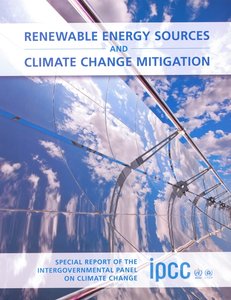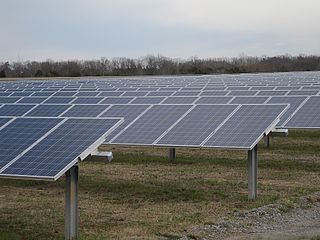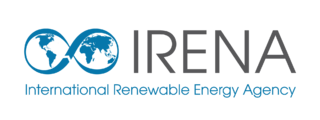
Renewable energy, green energy, or low-carbon energy is energy from renewable resources that are naturally replenished on a human timescale. Renewable resources include sunlight, wind, the movement of water, and geothermal heat. Although most renewable energy sources are sustainable, some are not. For example, some biomass sources are considered unsustainable at current rates of exploitation. Renewable energy is often used for electricity generation, heating and cooling. Renewable energy projects are typically large-scale, but they are also suited to rural and remote areas and developing countries, where energy is often crucial in human development.

The International Energy Agency (IEA) is a Paris-based autonomous intergovernmental organisation, established in 1974, that provides policy recommendations, analysis and data on the global energy sector. The 31 member countries and 13 association countries of the IEA represent 75% of global energy demand.

Hydroelectricity, or hydroelectric power, is electricity generated from hydropower. Hydropower supplies one sixth of the world's electricity, almost 4,500 TWh in 2020, which is more than all other renewable sources combined and also more than nuclear power. Hydropower can provide large amounts of low-carbon electricity on demand, making it a key element for creating secure and clean electricity supply systems. A hydroelectric power station that has a dam and reservoir is a flexible source, since the amount of electricity produced can be increased or decreased in seconds or minutes in response to varying electricity demand. Once a hydroelectric complex is constructed, it produces no direct waste, and almost always emits considerably less greenhouse gas than fossil fuel-powered energy plants. However, when constructed in lowland rainforest areas, where part of the forest is inundated, substantial amounts of greenhouse gases may be emitted.

Energy is sustainable if it "meets the needs of the present without compromising the ability of future generations to meet their own needs." Most definitions of sustainable energy include considerations of environmental aspects such as greenhouse gas emissions and social and economic aspects such as energy poverty. Renewable energy sources such as wind, hydroelectric power, solar, and geothermal energy are generally far more sustainable than fossil fuel sources. However, some renewable energy projects, such as the clearing of forests to produce biofuels, can cause severe environmental damage.

The Renewable Energy and Energy Efficiency Partnership (REEEP) is a Vienna-based Quasi-International Organisation that advances markets for renewable energy and energy efficiency with a particular emphasis on the emerging markets and developing countries.

Renewable energy commercialization involves the deployment of three generations of renewable energy technologies dating back more than 100 years. First-generation technologies, which are already mature and economically competitive, include biomass, hydroelectricity, geothermal power and heat. Second-generation technologies are market-ready and are being deployed at the present time; they include solar heating, photovoltaics, wind power, solar thermal power stations, and modern forms of bioenergy. Third-generation technologies require continued R&D efforts in order to make large contributions on a global scale and include advanced biomass gasification, hot-dry-rock geothermal power, and ocean energy. In 2019, nearly 75% of new installed electricity generation capacity used renewable energy and the International Energy Agency (IEA) has predicted that by 2025, renewable capacity will meet 35% of global power generation.

The World Wind Energy Association (WWEA) is an international non-profit association representing the wind power sector worldwide, with members in 100 countries, amongst them the leading national and regional wind energy associations. The organisation works for the promotion and worldwide deployment of wind energy technology and advocates a future energy system based on renewable energy.
International Renewable Energy Alliance is a formal partnership entered into on 4 June 2004 by five non-profit international renewable energy organisations:

Clean Energy Trends is a series of reports by Clean Edge which examine markets for solar, wind, geothermal, fuel cells, biofuels, and other clean energy technologies. Since the publication of the first Clean Energy Trends report in 2002, Clean Edge has provided an annual snapshot of both the global and U.S. clean energy sector markets.

The renewable-energy industry is the part of the energy industry focusing on new and appropriate renewable energy technologies. Investors worldwide have paid greater attention to this emerging industry in recent years. In many cases, this has translated into rapid renewable energy commercialization and considerable industry expansion. The wind power, solar power and hydroelectric power industries provide good examples of this.

Peter Elliot Rae AO is an Australian retired politician who represented the Liberal Party for the state of Tasmania in the Australian Senate. He served as a Senator from 1967 until his resignation in January 1986. He was subsequently elected to the division of Bass in the Tasmanian House of Assembly at the February 1986 election, serving until his defeat on 13 May 1989.

The United Nations Intergovernmental Panel on Climate Change (IPCC) published a special report on Renewable Energy Sources and Climate Change Mitigation (SRREN) on May 9, 2011. The report developed under the leadership of Ottmar Edenhofer evaluates the global potential for using renewable energy to mitigate climate change. This IPCC special report provides broader coverage of renewable energy than was included in the IPCC's 2007 climate change assessment report, as well as stronger renewable energy policy coverage.
The International Renewable Energy Conference (IREC) is a meeting of senior-level representatives, such as those from the Executive and Legislative branches of national or sub-national governments, international organizations, the finance and business community, or civil societies, working towards the advancement and integration of renewable energy in their countries.
The International Hydropower Association (IHA) is an international lobby group and membership association representing the global hydropower sector.

Solar power in Wyoming has the potential to generate 72 million MWh/yr. Wyoming used 12 million MWh in 1999. Net metering is available to all consumers generating up to 25 kW. The state has an installed capacity of 146 MW as of 2022.

Solar power in Maine on rooftops, utilizing 6,300 megawatts (MW) of solar panels, can provide 60% of the electricity used in Maine according to a 2016 U.S. Department of Energy study. Maine and Vermont are tied for the second highest rooftop solar potential in the country, only behind the state of California. A 2020 estimate suggests that a typical 5.6 kilowatt (kW) residential system will pay for itself in 6-7 years and generate a profit of $45,000 over the rest of its 25-year life from the tax credits and utility savings.

Solar power in Tennessee is capable of producing much of the state's electricity; however, the industry remains in early stages in the state. With 129 MW of solar power in 2015, Tennessee ranked 20th among states for installed solar capacity.
Eric Martinot is senior research director with the Institute for Sustainable Energy Policies in Tokyo, Japan, specialising in renewable energy commercialization. He is author of the 2013 REN21 Renewables Global Futures Report, and former lead author of the REN21 Renewables Global Status Report (2005–2010), an annual compilation of progress with renewable energy worldwide.

The International Renewable Energy Agency (IRENA) is an intergovernmental organization mandated to facilitate cooperation, advance knowledge, and promote the adoption and sustainable use of renewable energy. It is the first international organisation to focus exclusively on renewable energy, addressing needs in both industrialised and developing countries. It was founded in 2009 and its statute entered into force on 8 July 2010. The agency is headquartered in Masdar City, Abu Dhabi. The Director-General of IRENA is Francesco La Camera, a national of Italy. IRENA is an official United Nations observer.















